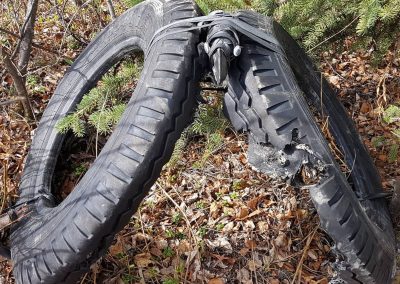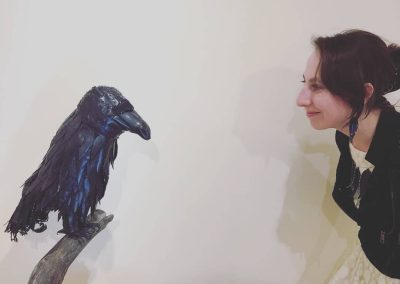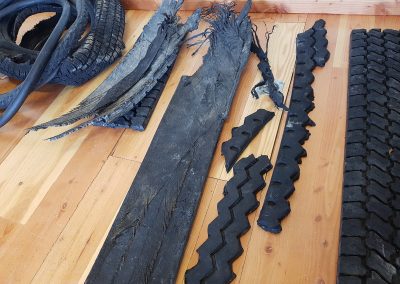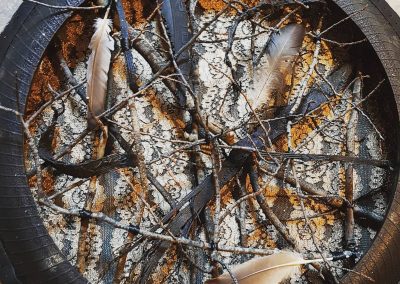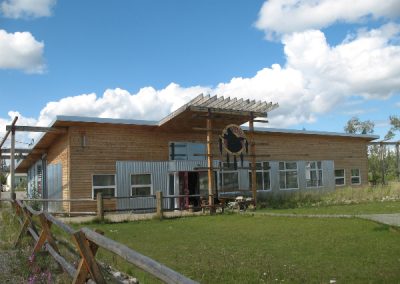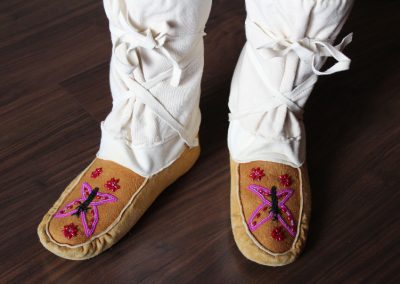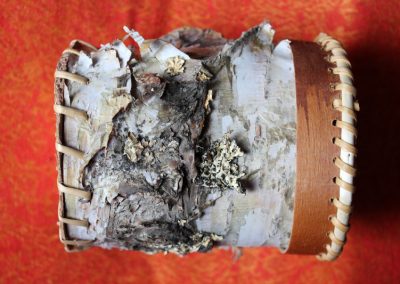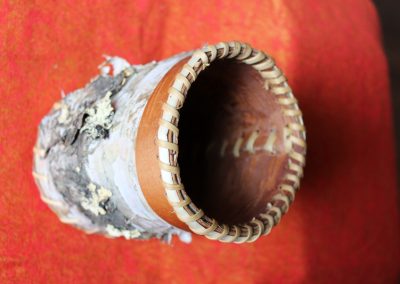Reuniting a divergent past, reasserting the road ahead
Originally from Beaver Creek – population 80, on the border between Alaska and Yukon – Teresa Vander Meer-Chassé has her sights set on the bigger picture.
The 26-year-old beadwork artist is grounded in her community, but is also curious about the world outside her hometown. She made the decision to base her beading operations out of Whitehorse – a rite of passage for people from smaller communities who wish to develop their careers.
Vander Meer-Chassé is a member of White River First Nation. At 250 members, it happens to be the smallest First Nation group in Yukon Territory. Vander Meer-Chassé is one of three residents who have chosen to make a living off of their traditional art.
Exposure – Community Face
Her work has garnered widespread support from her First Nation. Vander Meer-Chassé says the community is happy whenever members’ works are featured in public.
It’s a point of pride for the beader to call Beaver Creek her hometown. Each time Vander Meer-Chassé returns to her birthplace, she feels “at home” – she draws inspiration from the town’s extensive history, which dates back to the first signs of human civilization on the continent: 14,000 years ago, migrants passed through the region known as Beringia as they spready throughout the continent.
“When I go to Beaver Creek it feels, it feels right, you know what I mean?” Vander Meer-Chassé says.
Cultural organizations and funders are devoting more attention and supports to northern communities. This includes the Canada Council for the Arts, who launched an Indigenous arts-specific funding stream, Creating, Knowing and Sharing, in April 2017. Vander Meer-Chassé says it’s a good start, but it has to go further than email outreach alone.
“You have to go there, you have to make a connection, you have to become a part of the community in some way,” says the beader. She has a message for well-intentioned funders: “Your face has to be recognizable before they take the next step… of doing it consistently.”
Making a contemporary living from the arts
Vander Meer-Chassé picked beading back up in earnest about five years ago. She was coming back to the craft for the first time since she’d been gifted a bead and needle set by her grandma at age seven.
Vander Meer-Chassé works hard, and she works strategically: she prepares certain products for quick sells at craft shows, gift shops and the like, and she receives artist fees when she shows her work at galleries. Artist grants offset her other expenses.
It’s taken her four years of working full-time in the arts to get to where she is. She “absolutely” acknowledges that putting a monetary value on a historically priceless art is shaking up tradition: in the past, Indigenous communities gifted art and cultural relics through a sharing culture. For Vander Meer-Chassé’s reality, “it’s a science of how to actually make it as a full-time artist.”
Money matters: the inroads of government funding
Vander Meer-Chassé was a recipient of a major grant amount from the Canada Council for the Arts. In April 2017, the Council launched a new Indigenous arts funding stream called Creating, Knowing and Sharing; Vander Meer-Chassé received $50,989 to mount her public-private art sculpture project in schools between Beaver Creek and Whitehorse, as well as to curate workshops in Whitehorse and as far away as Montreal.
Alongside her project partner Nicole Bamberger, the pair was able to mount a public-private installation between January and May 2018 called Scavenging for Raven. They fashioned raven-inspired sculptural works from blown tire scraps – or “street washers,” as she refers to the treads personally salvaged from the road, or donated by people who respond to her open call on community forums.
Scavenging for Raven
All photos courtesy Teresa Vander Meer-Chassé
One branch of the project saw the women “putting little raven-inspired sculptures in people’s front yards” to bridge public art with private spaces, the other saw them touring schools in Haines Junction, Destruction Bay and Beaver Creek, dialoguing with students and adults on what the raven means to them and First Nations people.
Vander Meer-Chassé encourages artists to pursue Canada Council grants so that they can continue their work.
For Vander Meer-Chassé, the experience was successful in how it combined Indigenous and non-Indigenous forces. She sees it as a gesture towards reconciliation through the arts. “We want to write this grant and we’re going to get it, and we’re going to do this project,” the beader recalls thinking.
“It’s one form of reconciliation because it was an Indigenous person in the lead of a project with a non-Indigenous person and we’re both learning together, educating each other, but I wouldn’t say it’s the pinnacle of reconciliation, like, ‘Yes, she’s going to give me my land back!’ No! because she doesn’t have that power.
So when we’re talking about reconciliation, we can talk about ground-level, and the arts is definitely a part of that, like blanket exercise. That’s a form of art; that’s a form of performance art, and that’s teaching a lot of people across Canada the history of Indigenous Canada relations…when we talk about arts, that’s where social justice movements start.”
A modest beadwork artist
Vander Meer-Chassé has accepted external recognition and federal funding for her works, but she still holds close ties with her home community of Beaver Creek, where she is one of three officially recognized artists. Keeping her community’s unrecognized artists in mind, she sees her position as neither an honour nor pressure-inducing.
“I think it’s more frustration – I think a lot of people take that for granted that they have the privilege and the wealth to actually take some time to become a full-time artist,” she says. In her own case, she lives at home with her mom: since this frees her from many expenses, this allows her to focus full-time on her artistic output, personal enrichment and career planning. “There are other people in the community that have to work three, four jobs at a time so they can pay for their heating and everything like that,” Vander Meer-Chassé says. “They really don’t have time to do the art that they really do enjoy, or they’re doing it at night or they’re doing it when they’re eating or watching TV.”
Totem Pole – Cultural Appropriation
In December 2018, an incident involving Indigenous cultural appropriate arose out of Nova Scotia. As reported by CBC, NHL team-branded totem poles were being sold in a provincial drug store chain.
“Obviously there’s no totem poles over there,” Vander Meer-Chassé dismisses the authenticity of the items. “You can tell that this is not made by a First Nation person because it has nothing related to what our culture actually holds.” She wonders whether the artist reached out to any First Nations communities before taking the totem pole product to market. “They’re getting a lot of pushback from other Indigenous communities,” she says. “This isn’t just yours. This is shared,” Vander Meer-Chassé notes the homeland of the totem pole along the West Coast, from Alaska into British Columbia.
Elder permissions and consults
For her own peace of mind, Vander Meer-Chassé consults with her family and elders from her First Nation about her artistic choices. She wants them to hold her accountable in her actions, to authorize how art work is produced or shared outside the community.
And if she reaches a point in her career where she’s on the cusp of making top dollar, Vander Meer-Chassé says she will routinely touch base with her elders in order to balance out temptations of money and ethics with upholding her community’s art responsibly.
“I think it’s more of, They have the right. Like my grandma has the right to tell me: is this a culturally-sensitive object, or is this a culturally-sensitive piece of artwork that I should not be showing to the masses? Does this, like, hold some truth about our culture? Then I will not sell it. It will be held over here. But if it’s so contemporary that nobody knows what the heck I’m even doing then my grandma is like, ‘Well, I don’t know what you’re even doing. So yeah, go ahead.’ “
The politics of reconciliation: a grassroots organizing effort
Vander Meer-Chassé says that reconciliation doesn’t start until the oppressed community spearheads the movement – the healing process starts with them. “I find politicians, people like that are pushing for these ideas because they just want to get it over with,” she says. She brings up the European occupation of Indigenous land: “You took hundreds of years away from us, so you can wait another few hundred, you know?”
For non-Indigenous people looking to get engaged in the healing process, she encourages them to actively pursue alternate perspectives, whether it’s through taking a workshop, going to a course, or anything else to keep re-educating their understanding of the culture. “That’s just my perspective on what reconciliation means to me, is that people actually take those steps to learn for themselves,” Vander Meer-Chassé says.
As well-intentioned as they may be, Vander Meer-Chassé indicates that non-Indigenous people should gauge when they need to hold the floor, and when they need to step aside and leave community knowledge to its Indigenous members.
Vander Meer-Chassé is encouraged by the mobilization among First Nations people of her generation and younger. “When I make a post that is overtly political and I know that people won’t like it I tend to get messages from other young Indigenous Peoples, ‘Oh I totally agree but I just didn’t want to ever say it,’ ” she says. “A lot of people that experience residential school have a really hard time standing up for themselves.”
“It’s so much different when you actually go back home and you know where your family was born, where they hunted. That connection of just understanding that, ‘I am a descendant of those people that actually lived there and resided there for that length of time’ – it definitely warms the heart.”
Landmarks in Beaver Creek
History of Upper Tanana art
The traditional art of White River First Nation came out of functional needs more than aesthetics. Items like clothing, knife handles and spear tips served an everyday purpose for their nomadic lifestyle. Today the community artists use a distinctive moccasin floral pattern: one glance at the wearer’s feet, and others would know where they’re from. They have asserted a stronger cultural identity through their own art.
“I think arts is for sure going to be the one that’s going to expose a lot of wrongdoings that Canada has ever done to Indigenous Peoples. You can’t expect Indigenous to always be constantly be educating, because it is extremely exhausting, culturally exhausting. Your entire community – Indigenous, non-Indigenous – have to be full-heartedly ready for this. Because it’s going to change people’s perspectives; we’re asking people to change their ways, we’re asking people to change their minds. It’s a very hard thing to do, especially if they grew up in a form of whether they’re used to racism and things like that.”

